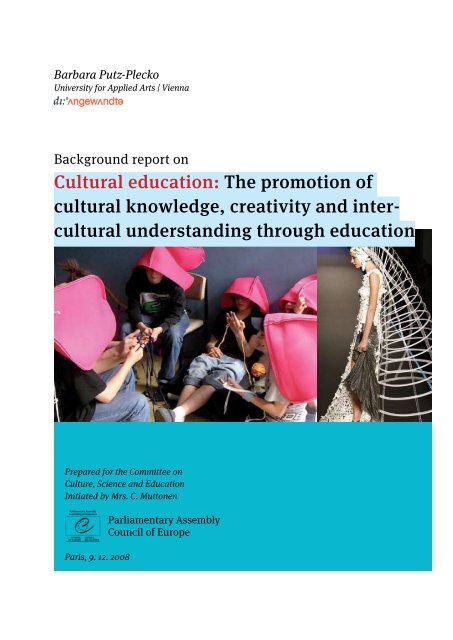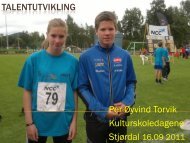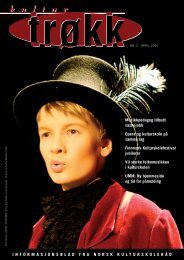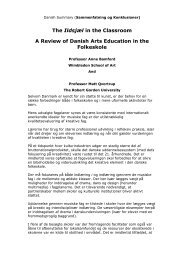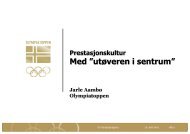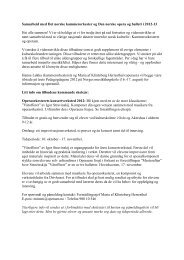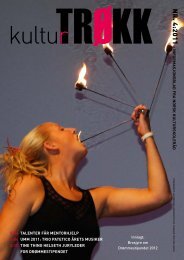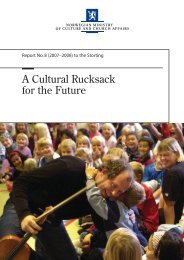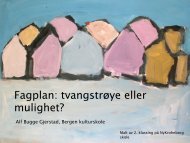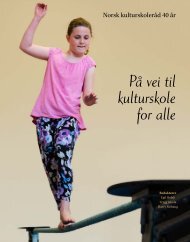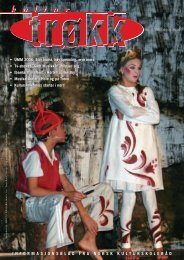Cultural education: The promotion of cultural knowledge, creativity ...
Cultural education: The promotion of cultural knowledge, creativity ...
Cultural education: The promotion of cultural knowledge, creativity ...
You also want an ePaper? Increase the reach of your titles
YUMPU automatically turns print PDFs into web optimized ePapers that Google loves.
Barbara Putz-Plecko<br />
University for Applied Arts | Vienna<br />
Background report on<br />
<strong>Cultural</strong> <strong>education</strong>: <strong>The</strong> <strong>promotion</strong> <strong>of</strong><br />
<strong>cultural</strong> <strong>knowledge</strong>, <strong>creativity</strong> and inter<strong>cultural</strong><br />
understanding through <strong>education</strong><br />
Prepared for the Committee on<br />
Culture, Science and Education<br />
Initiated by Mrs. C. Muttonen<br />
Paris, 9. 12. 2008<br />
Parliamentary Assembly<br />
Council <strong>of</strong> Europe
Barbara Putz-Plecko<br />
Background report on<br />
<strong>Cultural</strong> <strong>education</strong>: <strong>The</strong> <strong>promotion</strong> <strong>of</strong> <strong>cultural</strong> <strong>knowledge</strong>,<br />
<strong>creativity</strong> and inter<strong>cultural</strong> understanding through <strong>education</strong><br />
Art and Culture – Key Elements <strong>of</strong> Education<br />
An European Asset?<br />
„In matters <strong>of</strong> <strong>education</strong>, it is becoming very clear that society is changing: We no longer<br />
need the model that assumes there are a thousand obedient worker bees for each queen bee.<br />
Everyone in the industrial sector tells me we are educating our young people for the<br />
demands <strong>of</strong> today. We don’t need people who think in straight lines. We need people who<br />
can see the wider picture; we need people who can make connections, unexpected connections.<br />
This is the area in which the arts are supreme, in which art and <strong>education</strong> can give<br />
more, in every respect, than any other discipline.”<br />
Simon Rattle 1)<br />
Education must take into account social challenges.<br />
Our world is characterised by rapid change, increasing globalisation and increasingly complex<br />
economic, societal and <strong>cultural</strong> relations.<br />
Information, <strong>education</strong> and <strong>knowledge</strong> are progressively becoming the driving forces<br />
behind our new social and economic structures. <strong>The</strong> qualifications and competences <strong>of</strong> our<br />
citizens are thus becoming our central “raw material” and, as such, crucial factors <strong>of</strong> international<br />
competition. <strong>The</strong>y are the key to every country’s future.<br />
If we are to meet these tremendous challenges with foresight and a sense <strong>of</strong> proportion, we<br />
need a suitable <strong>education</strong>al foundation that will set the necessary orientation benchmarks<br />
in this rapidly changing world and enable us to deal with it in a constructive and critical way. 2)<br />
In order to adequately prepare children and young people for vocational<br />
and social life, <strong>education</strong>al institutions must not only understand changes<br />
in needs but anticipate them.<br />
In this sense, art and culture are indispensable elements <strong>of</strong> a comprehensive <strong>education</strong>, the<br />
objective <strong>of</strong> which is to achieve the maximum benefit for and best possible development <strong>of</strong><br />
each and every individual and thus enable every individual to participate actively in society<br />
as a constructive member <strong>of</strong> the community.<br />
<strong>The</strong> ability to capably handle the challenges encountered by each individual and by society,<br />
the capacity to deal responsibly with resources and the environment, well-developed interpersonal<br />
and communication skills and a well-developed faculty <strong>of</strong> reflection, as well as the<br />
ability to learn, to make decisions and to act competently – all these are <strong>education</strong>al goals<br />
which, when achieved, contribute substantially to a satisfying life.<br />
In this context, experience with art facilitates learning processes that are <strong>of</strong> pivotal importance:<br />
for example, recognising and relating to what is different, or the capacity to develop<br />
transitions and interrelations within a heterogeneous group.<br />
Like science, art can contribute to an overall process <strong>of</strong> development in society as a result <strong>of</strong><br />
its view <strong>of</strong> the world and its approach to <strong>creativity</strong>. Moreover, <strong>cultural</strong> <strong>education</strong> creates a<br />
constructive basis for encounter and discussion, for coexistence and cooperation.<br />
1) Simon Rattle in the NDR<br />
Kultur broadcast “Simon Rattle<br />
– Querdenker auf Erfolgkurs”<br />
(2008; re-translated into English<br />
from the German-language<br />
source)<br />
2) Federal Ministry for Education,<br />
Science and Art, “Schule<br />
neu denken, Zukunft der Schule<br />
– Schule der Zukunft”, position<br />
paper <strong>of</strong> the committee <strong>of</strong><br />
<strong>education</strong> experts (Vienna,<br />
2003)<br />
Barbara Putz-Plecko | Background report on <strong>cultural</strong> <strong>education</strong><br />
2
It is a foundation <strong>of</strong> general <strong>education</strong>, not a luxury that may be added when all other <strong>education</strong>al<br />
goals have been achieved. 3)<br />
<strong>The</strong> function <strong>of</strong> schools in society is not only to give our children <strong>knowledge</strong> and skills, but<br />
to open up spheres <strong>of</strong> experience and development in which young people can get to know<br />
themselves and become familiar with the world, and which will comprehensively foster the<br />
development <strong>of</strong> their personalities.<br />
3) German Commission for<br />
UNESCO, “Kulturelle Bildung<br />
für alle. Von Lissabon 2006<br />
nach Seoul 2010” (Bonn, 2008)<br />
Example 1: School as a <strong>cultural</strong> centre. Staging curtain materials; developing possible roles inspired by fragments <strong>of</strong> costumes and space.<br />
Starting point: spontaneous theatre. Playful approach to variations in self-dramatisation. Examination and reflection on intentional and<br />
unintentional effects, experimentation with possibilities <strong>of</strong> social interaction. Interaction <strong>of</strong> different levels <strong>of</strong> the creative design process.<br />
“Education in the arts” and <strong>education</strong> “through the arts” open up access to<br />
a more widely defined <strong>cultural</strong> <strong>education</strong> and are an essential part <strong>of</strong> it at<br />
the same time.<br />
<strong>The</strong> aim <strong>of</strong> <strong>education</strong> must be to promote the full development <strong>of</strong> the personality, talents,<br />
and mental and physical capabilities <strong>of</strong> each individual child. 4)<br />
<strong>Cultural</strong> <strong>education</strong>, that is, <strong>education</strong> in the arts and <strong>education</strong> through the arts (which<br />
means the use <strong>of</strong> art-based forms <strong>of</strong> teaching as a pedagogic tool in all kinds <strong>of</strong> school subjects),<br />
as examined by Anne Bamford in her systematised and comparative global review<br />
written for UNESCO, entitled “<strong>The</strong> WOW Factor”, makes an important contribution to the<br />
achievement <strong>of</strong> this aim. It is, in effect, a motor <strong>of</strong> individual development.<br />
4) Article 29 <strong>of</strong> the Declaration<br />
<strong>of</strong> Human Rights<br />
Increasingly, parents are coming to recognise this. In Austria, at least, the most recent <strong>cultural</strong><br />
monitoring study carried out by the Institute for Empirical Social Research (Ifes, Institut<br />
für Empirische Sozialforschung) showed that parents would like to see more art and culture<br />
in the schools because they believe that <strong>cultural</strong> <strong>education</strong> plays an extremely important<br />
role in the comprehensive development <strong>of</strong> their children’s personalities. And just recently,<br />
the Nordic Council identified <strong>cultural</strong> <strong>education</strong> as an area that needs to be more intensively<br />
focussed on by the schools in the coming years and correspondingly expanded and developed.<br />
5) Anne Bamford, <strong>The</strong> WOW<br />
Factor. Global research compendium<br />
on the impact <strong>of</strong> the<br />
arts in <strong>education</strong>. Waxmann;<br />
Münster/ New York/München/<br />
Berlin; 2006<br />
Artistic processes relate to the world “differently”.<br />
Learning is a creative process. What we learn depends, for the most part, on how we learn:<br />
on the learning place and learning atmosphere, the time, the rhythm and the clearness <strong>of</strong><br />
presentation.<br />
Learning by means <strong>of</strong> art-based methods opens up specific spheres <strong>of</strong> experience and development<br />
– an easily recognisable fact that has been examined and described in numerous<br />
studies. This form <strong>of</strong> learning is distinguished by the particular vividness and clarity with<br />
Barbara Putz-Plecko | Background report on <strong>cultural</strong> <strong>education</strong><br />
3
which <strong>knowledge</strong> and ideas can be communicated. And it promotes a positive understanding<br />
<strong>of</strong> diversity, <strong>of</strong> different approaches and <strong>of</strong> multi-perspective ways <strong>of</strong> viewing things –<br />
for example, by directly conveying the insight that there is more than one reasonable answer<br />
and more than one solution to a problem.<br />
Not only demographic changes – which the schools are now having to deal with constructively<br />
– have made it clear that a homogeneous culture for all simply does not exist, and<br />
that, more than ever before, we are being called upon to take this into account.<br />
A sensual approach lets children discover new worlds and come to grips with them in playful<br />
ways.<br />
Example 2: textil:mobil was cooperative project that ran for a number <strong>of</strong> years between students <strong>of</strong> the Department <strong>of</strong> Textiles at the University<br />
<strong>of</strong> Applied Arts in Vienna, Austrian schools and a business. <strong>The</strong> goal was to promote a “material literacy” that was in the process <strong>of</strong> disappearing<br />
on the one hand and, on the other, to promote a learning culture that by using a sensual approach and joint artistic student work<br />
was intended to awaken curiosity, enjoyment and interest as well as leading to the formulation <strong>of</strong> relevant questions. <strong>The</strong>se questions were<br />
explored and a number <strong>of</strong> works created that were spatially oriented and, above all, body oriented. <strong>The</strong>y addressed issues related to the lives<br />
<strong>of</strong> young people, rendered their patterns <strong>of</strong> play and action visible, created references to their surroundings and tested new approaches.<br />
<strong>The</strong> essential elements are: perception and <strong>creativity</strong>, the enjoyment and adventure <strong>of</strong> seeing<br />
and hearing, <strong>of</strong> trying things out, <strong>of</strong> simulating, playfully transforming, and achieving<br />
new effects under controlled guidance – and, <strong>of</strong> course, time and again, invention. 6)<br />
It is a matter <strong>of</strong> providing an indispensable and different access to the outer and inner<br />
worlds (apart from the cognitive approach through technologies and media).<br />
6) Hartmut von Hentig, Kreativität.<br />
Hohe Erwartungen an einen<br />
schwachen Begriff (Munich,<br />
Vienna: Carl Hanser Verlag,<br />
1998)<br />
Example 3: Art <strong>education</strong> – educating through art. A primary school class examined the artworks in the exhibition “<strong>The</strong> artist who swallowed<br />
the world” by Erwin Wurm in the Museum <strong>of</strong> Modern Art in Vienna. In many different ways the exhibition <strong>of</strong>fered the visitor an opportunity to<br />
explore the relationship <strong>of</strong> artist and viewer from different perspectives. Visitors themselves became active and contributed to producing the work.<br />
Barbara Putz-Plecko | Background report on <strong>cultural</strong> <strong>education</strong><br />
4
It is a proven fact that we need sensual experiences in order to develop: neuroscientific<br />
research demonstrates how thinking is stimulated by the senses and that <strong>creativity</strong> requires<br />
neuroplasticity.<br />
Literacy—as an <strong>education</strong>al goal and key area <strong>of</strong> competence—must be<br />
more than language as a verbal means <strong>of</strong> expression and communication.<br />
Creative design takes place in many “languages”.<br />
<strong>The</strong> schools must provide the time and space for this development <strong>of</strong> linguistic and non-linguistic<br />
forms <strong>of</strong> expression. Experimental situations must be permitted or created that will<br />
allow young people to make discoveries and develop new things or new modes <strong>of</strong> performance<br />
– in their own language, in their own individual ways, in their own personal forms <strong>of</strong><br />
expression.<br />
Artistic processes are always search processes that involve a seeking <strong>of</strong> individual paths,<br />
and at the same time they are processes <strong>of</strong> creative thinking. <strong>The</strong>y bring new understanding<br />
<strong>of</strong> oneself in combination with greater understanding <strong>of</strong> and new connections with the<br />
world. And they produce insight and <strong>knowledge</strong> in a special way.<br />
Aesthetic <strong>education</strong>, <strong>education</strong> in the arts, is distinguished by a specific interaction <strong>of</strong> cognition<br />
and emotion. We know that people who do not learn to deal with emotional intelligence<br />
run the risk <strong>of</strong> developing large deficits in perception, in decision-making ability and<br />
in the capacity to cope with everyday life and social situations.<br />
Nevertheless: Surprisingly, very little is being done to put these insights into practice. A<br />
great number <strong>of</strong> good intentions are being expressed, but very few political measures are<br />
being taken that could facilitate and promote a paradigm shift.<br />
Increased effort has to be made to establish synergies between <strong>knowledge</strong>,<br />
skills and <strong>creativity</strong>. With few exceptions <strong>education</strong>al politics gets no<br />
further than paying lip service to these ideas.<br />
Time cuts and the setting <strong>of</strong> other <strong>education</strong>al focuses are reducing the scope <strong>of</strong> these areas<br />
<strong>of</strong> <strong>education</strong> in many European countries to such an extent that the potential <strong>of</strong> children<br />
and young people <strong>of</strong>ten remains disregarded. <strong>The</strong> result is that, on the one hand, young<br />
people’s chances for development are lost at an early age and, on the other hand, their<br />
potential remains untapped for society as a whole – even though society’s need for precisely<br />
the competences and qualities that are developed through artistic and <strong>cultural</strong> <strong>education</strong> is<br />
greater than ever.<br />
<strong>The</strong>se important competences and qualities are:<br />
• the faculty <strong>of</strong> discriminative observation and perception,<br />
• imagination, inventiveness and vision,<br />
• <strong>creativity</strong> as their practical application,<br />
• emotional intelligence,<br />
• individual capabilities <strong>of</strong> expression and language competence,<br />
• the ability to communicate,<br />
• the ability to efficiently select and evaluate information,<br />
• the understanding <strong>of</strong> relations and correlations,<br />
• a capacity for critical reflection,<br />
• the ability to relate thinking and action in creative as well as organisational processes<br />
and to use <strong>knowledge</strong> in accordance with specific requirements,<br />
• the capacity to make decisions independently,<br />
• the ability to implement ideas innovatively and<br />
• the capacity to create new interconnections.<br />
Barbara Putz-Plecko | Background report on <strong>cultural</strong> <strong>education</strong><br />
5
Creativity and the ability to innovate are decisive for sustainable economic<br />
and social development.<br />
At present we are at the end <strong>of</strong> the industrial age. <strong>The</strong> abilities and skills that were needed to<br />
safeguard the social order <strong>of</strong> industrial society are losing relevance. <strong>The</strong> modern working<br />
world is no longer primarily defined by demand, but rather by perpetual renewal and innovation.<br />
One <strong>of</strong> the most essential competences needed in the future will be the ability to<br />
decide, for the most part independently and unrelated to predefined work processes, which<br />
possible solution to a new problem is the right one. 7)<br />
Knowledge and <strong>creativity</strong> are the new economic factors. It is not raw materials and machines,<br />
capital and land, analysts say, that will be the driving forces <strong>of</strong> our economy in the<br />
future. <strong>The</strong> deciding factor in the success <strong>of</strong> countries and regions will be the competition<br />
for creative and innovative minds.<br />
“Creative <strong>education</strong>,” summarises Monika Kircher-Kohl, CEO and CFO <strong>of</strong> Infineon Austria,<br />
“is a precondition for innovative industry. <strong>Cultural</strong> <strong>education</strong> is the basis for people’s ability<br />
to work together productively with understanding and respect in teams and global organisations.<br />
Artistic <strong>education</strong> ensures that young people will find the courage to cross boundaries<br />
and thereby develop their personalities – not only their intellectual talents – to the full:<br />
Education in the sense <strong>of</strong> a democratic society is inextricably linked with these attributes!” 8)<br />
7) Richard Florida, <strong>The</strong> Rise <strong>of</strong><br />
the Creative Class …and how<br />
it’s transforming work, leisure,<br />
community, & everyday life<br />
(New York: Basis Books, 2002);<br />
also, Richard Florida and Irene<br />
Tinagli, “Technologie, Talente<br />
und Toleranz” in perspektive<br />
21, no. 31 (Potsdam: SPD Landesverband<br />
Brandenburg, July<br />
2006)<br />
8) Monika Kircher-Kohl, in May<br />
2007; cited in Michael<br />
Wimmer’s study for the Austrian<br />
Federal Ministry for Education,<br />
the Arts and Culture<br />
entitled “Vielfalt und Kooperation.<br />
Kulturelle Bildung in<br />
Österreich – Strategien für die<br />
Zukunft“ [Diversity and Cooperation.<br />
<strong>Cultural</strong> Education in<br />
Austria – Strategies for the<br />
Future] (2007)<br />
Example 4: design°mobil, an initiative <strong>of</strong> the Department <strong>of</strong> Design, Architecture and Environment for Art Education at the University <strong>of</strong> Applied<br />
Arts in Vienna supported by KulturKontakt Austria. During Designmobil processes the participants slip into the designer role. <strong>The</strong>y test out<br />
various brainstorming and design strategies and learn to become acquainted with the design process as a creative strategy for action.<br />
Amongst the themes are an analysis <strong>of</strong> stale codes, ergonomics and useability, creating a market and human factors. Experiencing design<br />
processes serves to reflect on the status quo and sounding out possible design solutions. <strong>The</strong> goal <strong>of</strong> this activity is breaking with convention,<br />
re-thinking things and opening up new areas for action.<br />
In this respect, adequate attention must be focussed on the multifaceted potential <strong>of</strong> young<br />
people, and conditions must be provided that allow this potential its full development.<br />
Unfortunately, up to now the promised paradigm shift has been reflected in the <strong>education</strong><br />
system to only a very limited extent, or has been responded to merely with tightly structured<br />
“creative training” sessions.<br />
Barbara Putz-Plecko | Background report on <strong>cultural</strong> <strong>education</strong><br />
6
Creativity needs freedom.<br />
It is something more than “superficial <strong>creativity</strong>”.<br />
But <strong>creativity</strong> – the ability to create something new – needs to be allowed to grow and develop<br />
in its own way and in its own time; it needs patience and faith. Creativity cannot be<br />
measured or produced according to scale. It cannot be categorised. It lives on freedom, not<br />
commands. (<strong>The</strong> problem is: <strong>The</strong> systems we have now are enormous categorisation and<br />
compartmentalisation machines, which oppose behaviour that diverges from the norm.)<br />
Creativity requires self-organised people and tolerant, open communities.<br />
This is what <strong>cultural</strong> <strong>education</strong> aims for.<br />
Inadequate and bad teaching are hindrances.<br />
However, the clear hierarchisation <strong>of</strong> school subjects, exacerbated by the OECD instrument<br />
<strong>of</strong> the PISA Study (at present, primary importance is given to the subjects that PISA tests)<br />
and coinciding, perhaps, with a prevailing mood <strong>of</strong> short-sighted utilitarianism in society, is<br />
not conducive to achieving this aim. This societal tendency to see and value only direct usefulness<br />
does not recognise larger interrelationships and does not look far enough ahead. Yet<br />
we know that the problems we face in the future can only be solved if, in addition to using<br />
rational approaches, we cultivate forms <strong>of</strong> communication that are capable <strong>of</strong> making complicated<br />
and complex situations perceptible and comprehensible. Only then can action be<br />
guided by <strong>knowledge</strong>.<br />
Artistic languages make an important contribution to the development <strong>of</strong> these kinds <strong>of</strong><br />
communication. But because <strong>of</strong> their mainly peripheral position in most <strong>education</strong> systems,<br />
or due to qualitatively inadequate teaching, not only are specific forms <strong>of</strong> intelligence and<br />
understanding not fostered, the very opposite is the case: they are actually obstructed.<br />
Teachers play a decisive role in awakening and encouraging creative<br />
potential. <strong>The</strong>y provide examples in the way they teach and through their<br />
personality.<br />
This is why teacher training is so important. Teachers must be capable <strong>of</strong> capturing their<br />
pupils’ interest and fostering their abilities in the sense described above and thus <strong>of</strong> presenting<br />
lessons clearly and competently enough to achieve these goals. At the same time, they<br />
must be interested in an interdisciplinary approach and have the corresponding capacity to<br />
work cooperatively.<br />
As a matter <strong>of</strong> fact, a large percentage <strong>of</strong> teachers are in favour <strong>of</strong> artistic and <strong>cultural</strong> activities<br />
and a number <strong>of</strong> them engage in such activities with commitment, which results in lasting<br />
positive effects for everyone involved. At the same time, there is an obvious disproportionality<br />
between the personal commitment required on the part <strong>of</strong> the teachers and the small<br />
amount <strong>of</strong> institutional support they receive in a system where openness for such activities<br />
is lacking. Often enough, teachers have to battle all kinds <strong>of</strong> structural resistance before<br />
they can carry out their activities.<br />
Art and <strong>education</strong>al institutions have an <strong>education</strong>al mandate.<br />
A new learning culture has to be promoted by enabling new learning communities<br />
and supporting networks.<br />
<strong>Cultural</strong> institutions, too, need to rethink their roles in connection with <strong>cultural</strong> <strong>education</strong>;<br />
generally, the production, presentation and preservation <strong>of</strong> the <strong>cultural</strong> heritage are placed<br />
in the foreground while <strong>education</strong> takes a back seat.<br />
In this respect, great differences are observable among the various countries <strong>of</strong> Europe. As<br />
far as mandates and measures relating to <strong>cultural</strong> and <strong>education</strong>al policy are concerned, a number<br />
<strong>of</strong> <strong>cultural</strong> institutions <strong>of</strong>fer <strong>cultural</strong> <strong>education</strong> programmes which are also school-oriented.<br />
Barbara Putz-Plecko | Background report on <strong>cultural</strong> <strong>education</strong><br />
7
Example 5: An art <strong>education</strong> programme in a border region. During the “signs” project, an art <strong>education</strong> project supported by KulturKontakt<br />
Austria, Austrian and Czech apprentices attending regional vocational schools were creatively concerned with the border area, the landscape<br />
and their living conditions. <strong>The</strong> goal was not only the extension <strong>of</strong> the real, external border area but also the challenge posed by borders and<br />
prejudices in the mind. <strong>The</strong> exemplary series <strong>of</strong> projects “Programm K3” is intended to motivate apprentices to independent <strong>cultural</strong> activities<br />
via a communicative exchange with <strong>cultural</strong> workers and artists which starts out from the realities <strong>of</strong> their own work and living situation.<br />
KulturKontakt Austria is active in the area <strong>of</strong> <strong>cultural</strong> <strong>education</strong> at the interface between <strong>education</strong>, art and culture. Innovative projects, programmes<br />
and methods <strong>of</strong> participative art and <strong>cultural</strong> <strong>education</strong> are developed here under a mandate from the Federal Ministry <strong>of</strong> Education,<br />
Art and Culture.<br />
<strong>The</strong>se vary from country to country. <strong>The</strong> fact is that for some time now, these institutions<br />
have been no longer measured by their artistic production alone, but also by their ability to<br />
attract an interested and informed public and to fulfil their <strong>education</strong>al function. Increasingly,<br />
this is leading to intensified contact between these “<strong>education</strong>al partners” and, at least<br />
in some European countries, to helpful accompanying structural measures.<br />
Moreover, some <strong>cultural</strong> institutions explicitly assume the <strong>cultural</strong> and political mission <strong>of</strong><br />
reaching socially disadvantaged and <strong>education</strong>ally underprivileged target groups, as well as<br />
<strong>of</strong> generally facilitating <strong>cultural</strong> participation for young people.<br />
An unfocussed use <strong>of</strong> terminology can lead to misunderstandings and false<br />
expectations.<br />
Aesthetic <strong>education</strong> thus leads, as it were, to the heart <strong>of</strong> <strong>cultural</strong> <strong>education</strong>. <strong>The</strong> important<br />
thing is to provide a sensual approach and a playful exposure to art and culture. Other<br />
essential elements are thought, communication and integrative processes.<br />
While artistic <strong>education</strong> starts with the subject, <strong>cultural</strong> <strong>education</strong> is dialogical in nature<br />
and focuses on the way people deal with their fellow human beings and with the environment.<br />
It contributes to people’s socialisation and strengthens their ability to participate<br />
actively in the life <strong>of</strong> society – at various levels and in a variety <strong>of</strong> ways.<br />
<strong>Cultural</strong> <strong>education</strong> has been on the European agenda for a number <strong>of</strong> years. It is not the particular<br />
concern <strong>of</strong> a few idealists interest in art and culture. It is a pr<strong>of</strong>essional sphere <strong>of</strong><br />
action in which teachers, <strong>cultural</strong> educators and artists work.<br />
<strong>The</strong>ir goal is to develop <strong>cultural</strong> competence – which is considered one <strong>of</strong> the key competences<br />
<strong>of</strong> the 21 st century. 9) <strong>Cultural</strong> competence develops and expands in the course <strong>of</strong> longterm<br />
learning processes if these are allowed to proceed at individual speeds. It evolves to the<br />
best advantage in a lifelong and life-accompanying <strong>education</strong>al process.<br />
It is in this respect that obstacles and questions arise: In a globalised society characterised<br />
by competition and pressure to perform, where do we find space and time for imagination,<br />
individuality and <strong>creativity</strong>, unoccupied zones for open, curious encounters, for constructively<br />
dealing with contradictions, for solidarity?<br />
9) Recommendation <strong>of</strong> the European<br />
Parliament and <strong>of</strong> the<br />
Council <strong>of</strong> 18 December 2006 on<br />
key competences for lifelong<br />
learning (OJ L 394 / 30.12.2006).<br />
Barbara Putz-Plecko | Background report on <strong>cultural</strong> <strong>education</strong><br />
8
Culture and <strong>cultural</strong> competence are understood differently.<br />
If we think about <strong>cultural</strong> competence and try to determine what it really is, we also have to<br />
reflect on what precisely is meant by culture. <strong>The</strong>re are a number <strong>of</strong> definitions, some <strong>of</strong><br />
them similar to one another and others contradictory, and they all can influence the<br />
approach taken with respect to necessary <strong>cultural</strong> policy measures.<br />
I shall single out those which exemplify the various positions and enable us to recognise the<br />
conflicting perspectives:<br />
Raymond Williams defines culture “as a whole way <strong>of</strong> life”, thus <strong>of</strong>fering the leitmotif <strong>of</strong> Anglo-<br />
American <strong>cultural</strong> studies, which dissolves the boundary between everyday culture and high<br />
culture and thereby significantly influences the European debate. 10)<br />
10) Raymond Williams, e.g. in<br />
<strong>The</strong> Long Revolution (London:<br />
Chatto and Windus, 1961. Reissued<br />
with additional footnotes,<br />
Harmondsworth: Penguin, 1965)<br />
Example 6: <strong>Cultural</strong> competence is defined in the recommendations <strong>of</strong> the European parliament and commission as a recognition <strong>of</strong> the<br />
importance <strong>of</strong> the artistic expression <strong>of</strong> ideas, experiences and feelings in various artistic media. Knowledge, abilities, preservation <strong>of</strong><br />
values and attitudes (such as respect and openness with regard to the diversity and <strong>cultural</strong> expression) are cited as components <strong>of</strong> <strong>cultural</strong><br />
competence. <strong>The</strong>se stretch from informed dealings with <strong>cultural</strong> heritage through openness towards the diversity <strong>of</strong> conflicting <strong>cultural</strong> practices<br />
in the present to visionary approaches that anticipate problematic and challenging positions in the future.<br />
Another broad definition is the definition <strong>of</strong> culture used by UNESCO. It describes culture as<br />
“the whole complex <strong>of</strong> distinctive spiritual, material, intellectual and emotional features<br />
that characterise a society or social group” (including modes <strong>of</strong> life, value systems, religious<br />
and other beliefs and traditions). 11)<br />
11) UNESCO World Conference<br />
on <strong>Cultural</strong> Policies in Mexico<br />
City, 1982<br />
<strong>The</strong> British “All Our Futures” report, which introduces the Creative Partnerships programme,<br />
describes culture as shared values and patterns <strong>of</strong> behaviour that characterise various<br />
social groupings and communities. Behind this is a multi<strong>cultural</strong> and multi-ethnic society<br />
in which <strong>cultural</strong> diversity is understood as a central idea <strong>of</strong> social and <strong>cultural</strong> policy. 12)<br />
12) National Advisory Committee<br />
on Creative and <strong>Cultural</strong><br />
Education (NACCCE), “All our<br />
Futures: Creativity, Culture and<br />
Education” (1999)<br />
Example 7: Two societies from many… If we regard it as essential to the future that we succeed in making <strong>cultural</strong> diversity accessible to our<br />
children, then it will be important to learn something <strong>of</strong> ourselves and the world from the various perspectives, intellectual paradigms and<br />
inventive paths <strong>of</strong>fered by art and culture in all its different forms.<br />
Barbara Putz-Plecko | Background report on <strong>cultural</strong> <strong>education</strong><br />
9
In Western Europe, particularly in the German-speaking countries, culture has up to now<br />
been seen as a tradition within the context <strong>of</strong> the history <strong>of</strong> ideas, a tradition which follows<br />
the ideal <strong>of</strong> the “cultivated person” held by educated middle-class intellectuals since the<br />
mid-18th century. In this context, high culture is considered an <strong>education</strong>al treasure, to<br />
which everyday culture and popular culture are seen, at times, in alarming contrast.<br />
Nevertheless, traditional, outdated <strong>cultural</strong> concepts have for some time been dissipating in<br />
the wake <strong>of</strong> a plurality <strong>of</strong> life styles that no longer submits to any binding canon <strong>of</strong> high art<br />
as a matter <strong>of</strong> course. To this extent, an up-to-date concept <strong>of</strong> <strong>cultural</strong> <strong>education</strong> is based on<br />
the assumption that there are areas <strong>of</strong> interaction at the interfaces <strong>of</strong> everyday culture and<br />
so-called high culture. 13)<br />
<strong>The</strong> ability to enter into inter<strong>cultural</strong> dialogue and trans<strong>cultural</strong> understanding<br />
will decide our future.<br />
13) Michael Wimmer, “Vielfalt<br />
und Kooperation. Kulturelle<br />
Bildung in Österreich – Strategien<br />
für die Zukunft”, study<br />
conducted for the Austrian<br />
Federal Ministry for Education,<br />
the Arts and Culture (2007)<br />
When we speak <strong>of</strong> culture and <strong>education</strong> today, we have to take into account global migrations,<br />
worldwide communication networks, international business groups and the problem<br />
<strong>of</strong> poverty, which concerns all societies.<br />
Europe, both as a <strong>cultural</strong> area and as an economic area, needs qualified citizens with inter<strong>cultural</strong><br />
competence, interest in linguistic diversity, the willingness to partake in innovative<br />
lateral thinking, a vigorous sense <strong>of</strong> social awareness and the capacity to act with solidarity.<br />
It is evident that diversity and a multi<strong>cultural</strong> environment tend to stimulate<br />
<strong>creativity</strong>. 14)<br />
<strong>The</strong> dialogue between the cultures and the discussion <strong>of</strong> similarities and differences – in<br />
other words, <strong>of</strong> Europe’s diversity – is the basis for harmonious and peaceful co-existence. It<br />
creates quality <strong>of</strong> life and opportunities for development for everyone and strengthens our<br />
sense <strong>of</strong> responsibility for a united Europe and for the world as a whole.<br />
14) Council Conclusion on<br />
promoting <strong>creativity</strong> and innovation<br />
through eduction and<br />
training; Council <strong>of</strong> the European<br />
Union, Brussel, 22.5.2008<br />
Educational policy that has as its goal tolerance and mutual understanding<br />
has the potential to transform the increasing multi<strong>cultural</strong>ism <strong>of</strong> European<br />
societies into an asset for <strong>creativity</strong>, innovation and growth. 15)<br />
15) as cited<br />
Example 8: project cooperation with international as well as non-European partners – trans<strong>cultural</strong> project work embedded in various social<br />
fields are an increasingly important part <strong>of</strong> the work <strong>of</strong> the Department <strong>of</strong> Art and Communication Practices at the University <strong>of</strong> Applied Arts<br />
in Vienna. <strong>The</strong> potential inherent in the practice <strong>of</strong> art and art <strong>education</strong> outside the conventional sites <strong>of</strong> art production and presentation<br />
will be examined. <strong>The</strong> aim is reflected practice in which new areas <strong>of</strong> experience and action are made available and within which all participants<br />
feel represented.<br />
Culture is understood as a process, as the production and exchange <strong>of</strong> shared meaning. It is in this sense that these projects follow up on<br />
the various levels <strong>of</strong> construction <strong>of</strong> the so-called Other and so-called ‘own’.<br />
Barbara Putz-Plecko | Background report on <strong>cultural</strong> <strong>education</strong> 10
<strong>Cultural</strong> <strong>education</strong> thus implies opening up our society by means <strong>of</strong> art and culture. Open<br />
forms <strong>of</strong> learning and shared creative processes create space for encounters and for dealing<br />
constructively with differences.<br />
This space has physical, intellectual, sensual, emotional and social dimensions.<br />
<strong>Cultural</strong> <strong>education</strong> cannot simply be prescribed.<br />
It requires a new culture <strong>of</strong> teaching and learning, which<br />
• is open and cooperative both internally and externally,<br />
• focuses on the needs <strong>of</strong> the pupils,<br />
• is open to innovative, interdisciplinary work and<br />
• is project-oriented.<br />
Example 9: Festival der Lampions.[Lantern Festival] Following an artist initiated project in the 80s, the asbl COOPERATIONS 1990 was founded<br />
in Wiltz(Lux.). Today COOPERATIONS is • a socio-<strong>cultural</strong> enterprise with a wide spectrum <strong>of</strong> activities focussed on pr<strong>of</strong>essional orientation<br />
and artistic practices, • a <strong>cultural</strong>, social and <strong>education</strong>al service provider, • an factor in regional development integrated into the development<br />
strategy for north-west Luxembourg. <strong>The</strong> association’s mission is the effective implementation <strong>of</strong>t “<strong>creativity</strong> as a hub for socio<strong>cultural</strong><br />
and socioeconomic participation”. COOPERATIONS’ programmes reflect this concept and today these are regarded as valuable tools in<br />
combating social exclusion on the one hand and, on the other, they are recognised as contributing to individual and local development.<br />
In this sense, the Austrian Minister <strong>of</strong> Education Dr. Claudia Schmied describes <strong>cultural</strong><br />
<strong>education</strong> as a central motif <strong>of</strong> the current development <strong>of</strong> the school system.<br />
It is a common concern and a dynamic process involving parents, pupils, teachers, school<br />
administrations, artists, <strong>cultural</strong> educators and the societal environment as well as the<br />
industrial, political and administrative sectors.<br />
Quality in <strong>cultural</strong> <strong>education</strong> is achieved by means <strong>of</strong> exchange and partnerships; a major<br />
factor in achieving such quality is thus the ability to cooperate.<br />
It is necessary to initiate and extend networks and partnerships between culture<br />
and working life that also includes civil society and other stakeholders.<br />
Such partnerships require the proper supporting framework conditions and supervision.<br />
And they succeed best in cases where such activities become a part <strong>of</strong> the overall strategic<br />
orientation <strong>of</strong> an institution.<br />
Essential preconditions for good cooperation are:<br />
• shared spaces for these types <strong>of</strong> learning,<br />
• common visions,<br />
• clear strategies,<br />
Barbara Putz-Plecko | Background report on <strong>cultural</strong> <strong>education</strong><br />
11
• mutual trust and shared responsibility,<br />
• good cooperation and<br />
• excellent communication between the partners.<br />
• <strong>The</strong> boundaries between schools and communities must be permeable;<br />
• excessive formalisation in the planning and implementation <strong>of</strong> activities must be avoided<br />
• and a more open discourse on quality must be achieved.<br />
• Commitment needs to be appropriately valued.<br />
In order to be able to learn from one another and pass on experience and <strong>knowledge</strong>, it is<br />
important<br />
• to document processes and results<br />
• and to set up data bases, systematise them and make them accessible. 16)<br />
Learning communities and <strong>education</strong>al policy measures need to be based<br />
on good practices, differentiated exchange and appropriate dissemination.<br />
16) Michael Wimmer, “Vielfalt<br />
und Kooperation. Kulturelle<br />
Bildung in Österreich – Strategien<br />
für die Zukunft” (2007)<br />
Overstepping institutional boundaries, attempting to break out <strong>of</strong> clearly delimited systems,<br />
does not, as a rule, proceed without conflicts. And it always demands above-average commitment.<br />
Stretching boundaries always begins with taking an interest in others. It requires<br />
openness for new things and the courage to become involved in something that could develop<br />
in unforeseen ways.<br />
<strong>The</strong> European goals - equality <strong>of</strong> opportunity for all, cosmopolitanism and<br />
justice - have to lead the way.<br />
If we are aware <strong>of</strong> the challenges that life today presents for individuals and the community<br />
– namely, not merely to tolerate <strong>cultural</strong> differences but to analyse them and come to understand<br />
the reasons behind their ever new manifestations, not to confuse integration with<br />
assimilation, and to see participation as a constructive and active “taking part” rather than<br />
only as something passive – then we have arrived at the core <strong>of</strong> <strong>cultural</strong> <strong>education</strong>.<br />
Example 10: In 2003 Simon Rattle, principal conductor <strong>of</strong> the Berlin Philharmonic, began a dance project in cooperation with Royston Maldoom<br />
and 250 children from very different social backgrounds living in Berlin. Stravinsky’s “<strong>The</strong> Rite <strong>of</strong> Spring” was rehearsed together and<br />
performed in the Trepow Arena am Treptower Park with great success. Embedded in a series <strong>of</strong> projects this cooperative effort was aimed at<br />
addressing young people from socially dysfunctional areas by using the production level to turn it into a joint space for experience and negotiation<br />
about the differing views <strong>of</strong> music, movement; <strong>of</strong> life and aims.<br />
Royston Maldoom, dance and choreographer, says:<br />
“Through dance we can connect both our inner selves and others, transcending barriers <strong>of</strong> language, race, gender, with the potential to overcome<br />
negative attitudes to our differing economic, social, religious and <strong>cultural</strong> background, and at the same time maintaining our own particular<br />
identity.”<br />
Barbara Putz-Plecko | Background report on <strong>cultural</strong> <strong>education</strong> 12
Whether it is language, media culture, music, visual culture and art, dance, drama, design,<br />
architecture, material culture, fashion, everyday culture, rites, forms <strong>of</strong> thinking and acting,<br />
or aspects <strong>of</strong> everyday culture that form the basis <strong>of</strong> <strong>cultural</strong> dialogue: we are drawing here<br />
on a treasure trove <strong>of</strong> languages and ways <strong>of</strong> articulating, <strong>of</strong> <strong>knowledge</strong> and experience, <strong>of</strong><br />
history and the present day.<br />
<strong>Cultural</strong> <strong>education</strong> grows out <strong>of</strong> learning processes that take the inner differentiations and<br />
complexities <strong>of</strong> culture into account. It lets us experience the learning process with the senses<br />
and allows us to internally comprehend how people, under different conditions, have<br />
understood the world, interpreted it, acted in it and changed it in different ways and continue<br />
to do so.<br />
Our openness for learning processes <strong>of</strong> this kind is continually being challenged.<br />
Example 11: „treffen“. What happens when artistic working methods are infiltrated into a system that has nothing to do with art? <strong>The</strong> example<br />
given here presents a series <strong>of</strong> works made during a week-long project in a care centre for people with special needs. It documents the<br />
intensive work processes <strong>of</strong> a group <strong>of</strong> men who were personally unable to make themselves verbally understood but who, over the course <strong>of</strong><br />
a week, developed a series <strong>of</strong> wooden sculptures that formulated their individual and group needs and communicated them to the system.<br />
<strong>The</strong> works dealt with the issues <strong>of</strong> increased privacy, communication with the outside world, the ambivalence between control and overview<br />
and the desire for self-administered rooms for meetings.<br />
It is when resources become scanty and insecurity grows, when a lack <strong>of</strong> opportunities<br />
allows no visions <strong>of</strong> the future, that borders are closed up tight and there is a tendency to<br />
retreat behind hardened constructions <strong>of</strong> what is one’s own and what is alien. Idealisations<br />
and demonisations are frequent side effects <strong>of</strong> this process. Deviations from what is familiar<br />
engender rejection and aggression, or are penalised with marginalisation. Discussions about<br />
identity and culture then <strong>of</strong>ten serve the purpose <strong>of</strong> justifying separation and exclusion.<br />
<strong>Cultural</strong> <strong>education</strong> programmes cannot work miracles, but they can introduce new perspectives,<br />
make restrictive views and actions perceptible, and challenge people to make a move –<br />
however small. In this sense they open up negotiation spaces, promote active debate and thus<br />
help to develop a conflict culture. (This can be compared to the work strategies <strong>of</strong> the Japan<br />
Foundation in the field <strong>of</strong> peacemaking.)<br />
Example 12: Bordergames is a project to empower young migrants through the process <strong>of</strong> designing and programming a videogame fully<br />
made by them. Bordergames comprises a series <strong>of</strong> workshops, a videogame engine and an editor which allows young migrants not only to<br />
design a video game in which their experiences are the main element, but also to learn the importance <strong>of</strong> becoming familiar with new technologies<br />
and using them to self-organise and recover control over their own lives and environments. www.bordergames.org Spain<br />
Barbara Putz-Plecko | Background report on <strong>cultural</strong> <strong>education</strong> 13
Parallel to the school, learning is increasingly taking place in informal contexts<br />
and during free time. ICT-based instruments <strong>of</strong> learning are on <strong>of</strong>fer<br />
and extremely helpful.<br />
In addition living outside the centres should not result in any disadvantages<br />
for the individual.<br />
<strong>The</strong> use <strong>of</strong> new technologies can develop these projects considerably further and open up<br />
entirely new dimensions for communication and negotiation.<br />
Example 13: “Here we only cook with love”. <strong>The</strong> illustrated “cookbook” is a document produced by a cooperative effort between art and art<br />
<strong>education</strong> students and the tenants <strong>of</strong> a high-rise complex on the outskirts <strong>of</strong> Vienna – a social hot spot with a high level <strong>of</strong> latent violence.<br />
Initial encounters in which cooking and eating together represented the central element <strong>of</strong> familial life led to stories about cooking and life<br />
that sketched an impressive portrait <strong>of</strong> the tenants and their worlds. By working jointly on the book, areas were opened up which the tenants<br />
had previously reacted to with disinterest or rejection, shyness or fear.<br />
Differences should be accepted and constructively negotiated.<br />
Every society is permeated with <strong>cultural</strong> differences. <strong>The</strong>y arise between generations as well<br />
as between different communities and sexes, between social groupings and between a variety<br />
<strong>of</strong> self-chosen affiliations. <strong>The</strong>y develop as a result <strong>of</strong> people’s different backgrounds and<br />
reflect different life situations. And we carry them inside us. <strong>The</strong>y construct identity. How<br />
we deal with these outer and inner differences plays a role in determining our future.<br />
In this sense, too, the growing importance <strong>of</strong> <strong>cultural</strong> <strong>education</strong> is confirmed in many ways.<br />
Example 14: Volco - a virtuel planet in cyberspace by and for children.<br />
Volco is an evolving Virtual Online Co-Operative environment, a planet in cyberspace being constructed by children and young people communicating<br />
via the Internet and making links across geographic and <strong>cultural</strong> divides. <strong>The</strong> project taps into the energy <strong>of</strong> popular net culture<br />
and facilitates co-operative relationships between participants <strong>of</strong> different backgrounds and life experiences, while enabling a new, virtual<br />
society to emerge out <strong>of</strong> their combined imaginations. Inventing VOLCO children explore new, imaginative and co-operative ways <strong>of</strong> creating<br />
a better life on their own planet. www.volco.org<br />
Barbara Putz-Plecko | Background report on <strong>cultural</strong> <strong>education</strong> 14
Excellent and exemplary practice works towards countering marginalisation,<br />
isolation and exclusion.<br />
A broad spectrum <strong>of</strong> projects and programmes can cater to the needs <strong>of</strong> a wide variety <strong>of</strong> target<br />
groups. Numerous best practice examples have been documented.<br />
Europe has a mandate relating to <strong>education</strong>al and <strong>cultural</strong> policy:<br />
But above and beyond the colourful practice <strong>of</strong> projects developed and implemented by<br />
dedicated educators, and apart from philosophic discourse, <strong>cultural</strong> <strong>education</strong> requires<br />
• a suitable infrastructure,<br />
• financial and human resources,<br />
• discourse among experts about content and objectives and<br />
• the appropriate political framework conditions.<br />
In this context, measures are needed in the area <strong>of</strong> <strong>cultural</strong> and <strong>education</strong>al policy, for<br />
example,<br />
• the coordination <strong>of</strong> individual measures,<br />
• advocacy and lobbying,<br />
• an intensification <strong>of</strong> European cooperation,<br />
• structural safeguarding <strong>of</strong> <strong>cultural</strong> <strong>education</strong> programmes in the schools and outside them,<br />
and<br />
• research funding.<br />
In conclusion, I should like to mention a number <strong>of</strong> examples <strong>of</strong> individual, committed initiatives,<br />
measures, institutions and advocates <strong>of</strong> <strong>cultural</strong> <strong>education</strong> in Europe:<br />
• UNESCO, Road Map for Arts Education. Developed within the framework <strong>of</strong> the World Conference<br />
on Arts Education: Building Creative Capacities for the 21st Century, Lisbon, 6–9<br />
March 2006<br />
• Kultur-Rucksack, Norway. <strong>The</strong> “Culture Rucksack” is a state programme aimed at bringing<br />
elementary school pupils in contact with the pr<strong>of</strong>essional art sphere.<br />
• Cooperations Wiltz Luxemburg; www.cooperations.lu<br />
• Creative Partnerships. A programme <strong>of</strong> the arm’s length organisation Arts Council England<br />
for schools in poor or disadvantaged areas, aimed at developing the creative abilities <strong>of</strong><br />
young people and strengthening their self-confidence and motivation; a cooperation <strong>of</strong><br />
pupils, teachers and creative practitioners.<br />
• Cultuurnetwerk Nederlands. Network <strong>of</strong> the Ministry <strong>of</strong> Education, Culture and Science <strong>of</strong><br />
the Netherlands.<br />
• Culture and School Network <strong>of</strong> civil servants from <strong>cultural</strong> and <strong>education</strong>al administrations:<br />
www.culture-school.net/network.htm; www.cultuurnetwerk.nl/glossary/ge/index.html<br />
• Canon Cultuurcel. <strong>Cultural</strong> entity <strong>of</strong> the Flemish Ministry <strong>of</strong> Education. Objective: <strong>promotion</strong><br />
and networking <strong>of</strong> the sphere <strong>of</strong> art and culture with teachers, pupils and extracurricular<br />
youth work.<br />
• Arts Awards. Qualification certificate awarded by the Arts Council England and Trinity<br />
Guildhall College. Individual learning programme which supports young people in their<br />
development as artists and arts leaders.<br />
• Kompetenznachweis Kultur. A “<strong>cultural</strong> qualification” certificate for children and young<br />
people, coordinated by the Bundesvereinigung kulturelle Jugendbildung (German federal<br />
association <strong>of</strong> <strong>cultural</strong> youth <strong>education</strong>).<br />
• CKV-Bonnen. Gutscheine für Kultur. Voucher system <strong>of</strong> the Ministry <strong>of</strong> Education, Culture<br />
and Science <strong>of</strong> the Netherlands that helps pupils and teachers finance participation in <strong>cultural</strong><br />
activities.<br />
• EDUCULT. An independent institute for culture and <strong>education</strong> in Vienna, Austria. Goal: To<br />
interlink culture and <strong>education</strong> in theory and practice.<br />
• KulturKontakt, Vienna, Austria. Centre <strong>of</strong> excellence for <strong>cultural</strong> <strong>education</strong>, <strong>cultural</strong> dialogue<br />
and <strong>education</strong>al cooperation with Central, Eastern and South Eastern Europe.<br />
Barbara Putz-Plecko | Background report on <strong>cultural</strong> <strong>education</strong> 15
credits<br />
Barbara Putz-Plecko is Vice-Rector <strong>of</strong> the University <strong>of</strong> Applied Arts Vienna and head <strong>of</strong> the<br />
Department <strong>of</strong> Art and Communication Practices / Textile Department, related to Art Education<br />
Programmes.<br />
2007/2008 she was a member <strong>of</strong> the committee <strong>of</strong> <strong>education</strong> experts <strong>of</strong> the Federal Ministry<br />
for Education, Arts and Culture.<br />
© Text: Barbara Putz-Plecko, 2008<br />
photo credits:<br />
• Cover: „Denkkappen“, („Caps for Thinking“) University <strong>of</strong> Applied Arts, Vienna, Textile<br />
Department, Univ. Pr<strong>of</strong>. Barbara Putz-Plecko; Costume © Jean-Paul Gaultier<br />
• Page 3: University <strong>of</strong> Applied Arts, Vienna, Department <strong>of</strong> Art and Communication Practices<br />
/ Textile Department, B. Putz-Plecko<br />
• Page 4: „textil:mobil“, University <strong>of</strong> Applied Arts, Vienna, Textile Department, B. Putz-<br />
Plecko<br />
• Page 6: „design°mobil“, University <strong>of</strong> Applied Arts, Vienna, Department <strong>of</strong> Design,<br />
Architecture and Environment for Art Education, Univ. Pr<strong>of</strong>. James Skone<br />
• Page 8: Land-Art Project „Signs“, 2006, Kulturkontakt, @ Doris Prenn/prenn_punkt,<br />
• Page 9: Guggenheim Museum, Bilbao; Trulli, Sardegna; Schloss Schönbrunn, Vienna;<br />
Farmhouse, Black Forest, Deutschland; Edouard Manet, <strong>The</strong> Luncheon on the Grass; Punks,<br />
London, GB<br />
• Page 10: „UGATRA Project“ University <strong>of</strong> Applied Arts, Vienna, Department <strong>of</strong> Art and<br />
Communication Practices / Textile Department, B. Putz-Plecko<br />
• Page 11: asbl COOPERATIONS, Wiltz, Luxembourg<br />
• Page 12: Rhythm is it!, Simon Rattle, Royston Maldoom and 250 children in Berlin<br />
• Page 13: Projekt Treffen; www.Bordergames.org<br />
• Page 14: www.volco.org<br />
English translation: Beverly Blaschke, Tim Sharp<br />
Traduction française: Traude Chatel<br />
Graphic design: Studio Putz+, www.ewigesarchiv.at<br />
Download report: www.dieangewandte.at/aktuell<br />
Barbara Putz-Plecko | Background report on <strong>cultural</strong> <strong>education</strong> 16


